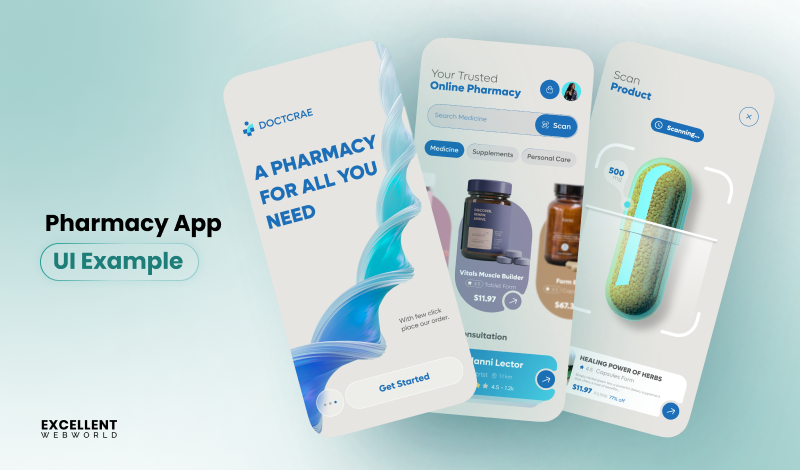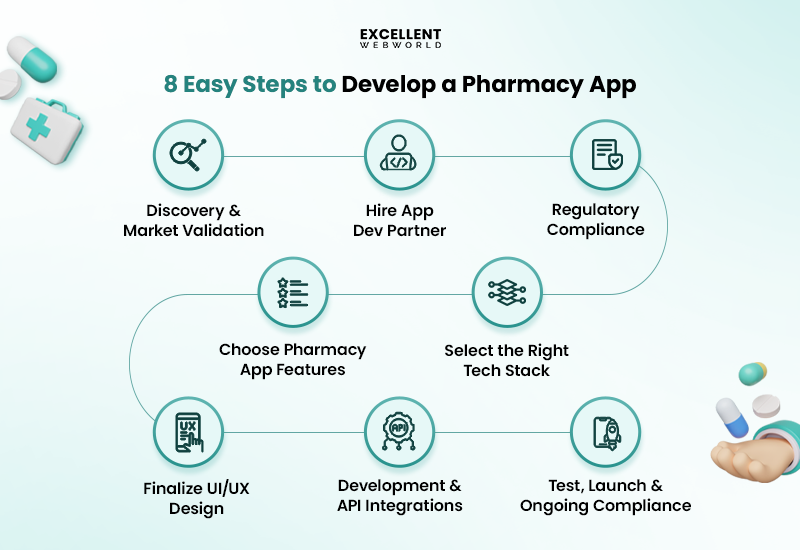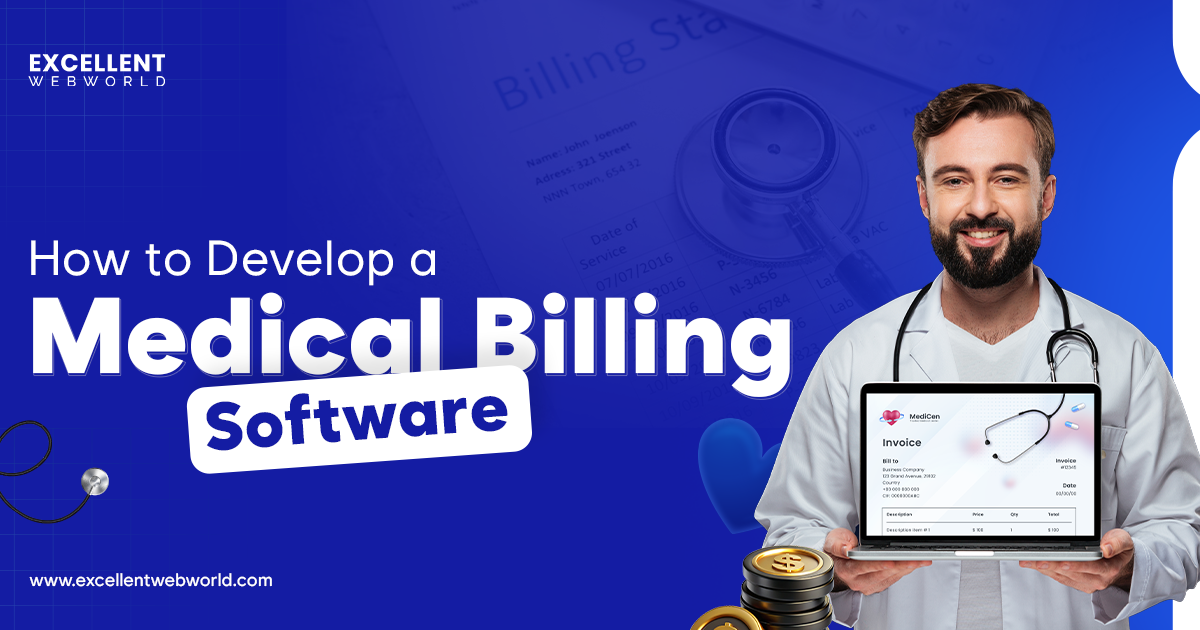Pharmaceuticals are already an evergreen business because they meet a necessity. They aren’t just a fleeting trend. As long as the existence of life remains on planet Earth, the pharmacy business is here to stay. If you’re planning to step into the pharmacy sector, which roughly accounts for USD 150.7 billion worth of market, or are already a part of it with a brick-and-mortar pharmacy store, choosing to go for pharmacy app development isn’t just a smart investment. It’s the only way you can futureproof your business.
From an entrepreneur’s perspective, developing a pharmacy app isn’t just about selling medicines online. It’s about tapping into recurring demand, building scalable revenue streams, and creating a brand that sticks with users for the long run. For traditional brick-and-mortar pharmacies, a well-built app can help manage inventory efficiently, connect with local customers, and expand their reach beyond the physical store. But to achieve all these, you need a well-built pharmacy app, which requires a proper development guide like we wrote.
At Excellent Webworld, we’ve helped many healthcare startups and enterprises transform these opportunities into scalable, revenue-generating pharmacy apps. Leveraging our 13+ years of expertise, we have created this pharmacy app development guide that covers the necessary steps, features, compliance, tech stack, and cost.
If you want to build the best, then don’t make the mistake of skipping it; there are useful pro tips from experts at every step to make your journey easy.
What is a Pharmacy App Development?
Pharmacy app development is a process of creating a mobile or web application that is able to manage medication and related services. It is not just an on-demand medicine delivery solution; it’s a digital platform in the healthcare industry that is crafted to bridge customers, pharmacies, and healthcare providers. The pharmacy app enables users to order medicines, upload prescriptions, track deliveries, and even consult pharmacists without setting foot out of the home.
But the advantage of online pharmacy app development is that it completely transforms traditional pharmacies into scalable, tech-driven businesses. Instead of being limited to a local store, pharmacies can reach a city, a state, or even an entire country by building one app.
Building an app for the pharmacy sector isn’t just about a single interface tool; it’s an ecosystem that connects customers, pharmacists, delivery agents, and admins to interact seamlessly. That’s why, before jumping into all the steps of pharma app development, you have to first understand the different modules with their tailored features for each role.
Let’s move to the next section for a quick and better understanding of well-defined pharma app modules.
What Are the Core Modules of a Pharmacy App Development?
A pharma application development consists of separate modules for each role, including customers, pharmacists, delivery agents, and admins. All these modules have tailored features according to an individual’s role, which ensure smooth ordering, prescription management, medicine deliveries, and overall business operations.
| Pharmacy App Module | What Is It For? | Key Features |
|---|---|---|
| Customer Module | Enables patients to order medicines seamlessly and track their delivery in real time. | |
| Pharmacist Module | Helps pharmacists manage stock, prescriptions, and other business operations efficiently. | |
| Delivery Agent | Make sure medicines reach the customer’s doorstep quickly and securely through optimized delivery. | |
| Admin Panel | Offer full control over pharmacies, compliance, and business performance (This module is for you). |
What Are the Key Steps in Pharmacy App Development?
Developing a pharmacy app involves structured steps. From compliance checks to feature integration, ensuring security, scalability, and user trust is crucial when you are building an on-demand pharmacy app. The right development approach can turn a simple idea into a profitable digital healthcare business. Let’s understand every step one by one.
Step 1: Discovery & Market Validation
Like every other healthcare app development, market research and idea validation are the first steps of building a pharmacy app. It is crucial to check the feasibility of the pharmacy app concept for your business with proper market research. Make sure you do the following things in the market research:
This strategic market research for the on-demand pharmacy app industry ensures you build a pharmacy solution that is both profitable and genuinely useful.
Step 2: Hire the Right Healthcare App Development Partner
There are many app development companies out there, but efficient pharmacy app development requires domain expertise. Handling e-prescriptions, compliance, and AI-powered integrations isn’t something every app developer can manage effectively.
Hiring an experienced healthcare app development company like Excellent Webworld, which has expertise in building on-demand pharma apps as well as AI development services and ensures security, scalability, and faster time-to-market.
Although you can build your in-house team by hiring developers who have proficiency in technologies that are used to build pharma apps, in that case, you are responsible for handling the complete project. That’s why many companies prefer outsourcing over in-house teams.
Pro Tip: Choose a partner with proven healthcare projects, not just generic apps. Ask about their portfolio and compliance expertise (HIPAA, GDPR, NDHM) before signing the final contract.
Step 3: Legal & Regulatory Compliance
Pharmacy apps handle patient profiles, prescriptions, medical records, real health conditions, payment details, and sensitive user data. Ensuring app compliance is critical to avoid unnecessary legal penalties and build trust among patients who use your platform. With respect to the region, each has its own standards that your app must meet.
| Region | Compliance Standard | Purpose |
|---|---|---|
| USA | HIPAA-Compliant App Development | Helps in protecting patient health data. |
| EU | GDPR & MDR App Development | Used to claim data privacy and medical device regulations. |
| India | NDHM & CDSCO App Development | Associated with healthcare data and drug delivery compliance. |
| Global | ISO 13485 & HL7 App Development | Ensure quality management and interoperability standards. |
Step 4: Pharmacy-Specific Feature Planning
Feature planning is the preparation of how your pharmacy app works. From this step, you translate business needs into a working product. Make sure you are focusing on finalizing pharmacy app features that make it unique and stronger than your competitors.
Integrating features such as prescription uploads, dosage reminders, and real-time stock checks makes your pharmacy app more valuable than any other solution. Here are some of the must-have pharmacy app features listed; have a look.
Step 5: Choosing the Right Tech Stack
Selecting the right app development technology is crucial while building a pharmacy app, as it ensures long-term scalability, security, and smooth integrations with healthcare APIs.
To stand out among all the competitors and innovate in the digital era, implementing AI in healthcare app development becomes a strategic step. That’s why it is important to check the compatibility of the tech stack you used with the artificial intelligence.
Let’s see some popular technology options that are best for pharmaceutical app development.
| Layer | Technology Options |
|---|---|
| Frontend | React Native, Flutter |
| Backend | Node.js, Django |
| Database | PostgreSQL, MongoDB |
| Cloud Hosting | AWS, Azure, GCP |
| APIs | RxNorm, Stripe, Twilio (SMS/alerts) |
| Security | OAuth 2.0, SSL, End-to-End Encryption |
Although technology selection for a pharmacy app also depended on the platform type you choose. You can build for Android, iOS, or both with cross-platform app development.
Pro Tip: Opt for a cross-platform development framework like Flutter for an on-demand pharmacy app; it helps launch faster without compromising performance.
Step 6: UI/UX Design for Healthcare Users
The audience segment of pharmacy apps is so wide, as it serves elderly patients, busy caregivers, health-conscious Gen Z, and pharmacists. That’s why for engaging your users, UI must be simple, legible, and stress-free. Use large fonts, clear CTA buttons, and reduce checkout steps to enhance user experience, which leads to an increase in conversions.
In most cases, the hired development partner will provide top UI/UX designers to create a user-friendly design. But if it’s not included in your contract or you have an in-house development team, then you have to hire proficient UI/UX designers from top app designing companies. This ensures you are crafting a scalable UI that benefits as businesses evolve and trend passes.
Pro Tip: Design for accessibility; elderly patients and non-tech-savvy users form a major chunk of pharmacy app users. Also, test pharmacy app UI with real patients/pharmacists, not just developers.
Step 7: Development & Healthcare API Integrations
This is the step where your app takes shape. You can first launch an MVP with core features, then develop a full-fledged solution. Mostly, founders embrace MVP development services to test performance with real users and develop the final version as per the feedback received on core features.
Pharmacy app development requires specialized drug databases, teleconsultation APIs, and payment gateway integrations. This ensures secure data flows and allows role-based access to pharmacists, patients/customers, and admins.
Based on the pharmacy app UI, start development with your experienced developers and integrate all the necessary healthcare APIs, including those for EHR System Development.
Pro Tip: Pharmacy app maintenance and compliance are a moving target; make sure you are setting a part of your budget for legal updates and regulatory audits.
How Much Does It Cost to Build a Pharmacy App?
Like every other app development cost, building a pharmacy app budget depends on multiple factors, such as features, compliance, development team location, UI/UX design, and complexity. From MVP to enterprise-grade, knowing the right price prediction helps plan strategically and avoid hidden expenses.
| App Type | Estimated Cost | Development Time |
|---|---|---|
| MVP (Minimum Viable Product) | USD 14,000 to 24,000 | 10 to 12 Weeks |
| Basic App | USD 18,000 to 28,000 | 12 to 14 Weeks |
| Medium Complexity App | USD 24,000 to 34,000 | 14 to 16 Weeks |
| High-Complexity App | USD 34,000 to 44,000 | 16 to 18 Weeks |
| AI-Powered App | USD 40,000 to 60,000+ | 18 to 22 Weeks |
***Please note that the above-mentioned price range and development time may vary depending on app complexity and other pre-discussed factors.***
Expert Advice to Save On Pharmacy App Development:
Prefer MVP app development in the initial stage as it doesn’t require a lot of investment and gives honest user feedback on core features. After that, you can invest in a full-fledged online pharmacy app development.
Final Thoughts: What’s the Final Dose on Pharmacy App Development?
Pharmacy app development isn’t just about launching another revenue-generating healthcare app; it’s about solving real problems like medicine accessibility, prescription tracking, and patient safety. From compliance and pharmacy-specific features to tech stack and costs, every step matters in shaping a pharmacy delivery app that users trust and rely on.
Excellent Webworld, rated as #1 healthcare app development company, we’ve helped startups and enterprises worldwide build secure, scalable, and user-friendly AI-powered pharmacy apps that stand out in the digital healthcare space.
Whether you’re planning an MVP or a full-fledged platform with EHR integration, our experienced professionals bring the technical expertise, compliance knowledge, and design innovation to make it happen. Let’s turn your pharmacy app idea into a profitable reality. Get in touch with us today!
FAQs on Pharmacy App Development
A pharmacy app lets users order medicines, track prescriptions, and access other healthcare-related services. Patients, pharmacists, hospitals, and even startups get advantages from its convenience and scalability.
Online pharmacy app development steps include market validation, legal compliance, defining features, choosing tech stack, UI/UX design, backend development, testing, deployment, and ongoing maintenance and compliance.
To prevent sensitive patient data, a pharmacy app must be compliant with HIPAA and GDPR. In addition to that, integrating data encryption, secure servers, and role-based access can protect a pharmacy app platform.
Popular technology stack choices for building a pharmacy app from a top pharmacy app development company include React Native/Flutter (frontend), Node.js/Django (backend), MongoDB/PostgreSQL (database), and AWS/Azure (cloud hosting).
A basic MVP for custom pharma software development can take 10 to 12 weeks, mid-level apps around 14 to 16 weeks, and enterprise-level and AI-powered solutions may require 16 to 18 weeks or more.

Article By
Mahil Jasani began his career as a developer and progressed to become the COO of Excellent Webworld. He uses his technical experience to tackle any challenge that arises in any department, be it development, management, operations, or finance.





